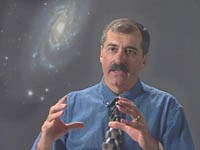Einstein's Dream of Unified Forces
How can we solve the mystery of dark energy?

View the Video
Recent measurements with telescopes and space probes have shown that a mysterious force—a dark energy—fills the vacuum of empty space, accelerating the universe's expansion. We don't know what dark energy is, or why it exists. Particle theory tells us that, at the microscopic level, even a perfect vacuum bubbles with quantum particles that are a natural source of dark energy. But a naïve calculation of the dark energy generated from the vacuum yields a value 10120 times larger than the amount we observe. Some unknown physical process is required to eliminate most, but not all, of the vacuum energy, leaving enough left to drive the accelerating expansion of the universe. A new theory of particle physics is required to explain this physical process.
Particle physics data point to another mysterious component of empty space, the Higgs field, which gives particles the property of mass. Without the Higgs field, electrons would fly at the speed of light, and atoms would instantly disintegrate. Are dark energy and the Higgs field related? The discovery of supersymmetry would provide crucial evidence of a possible connection. Supersymmetry provides both a natural context for the Higgs field and a possible explanation for the small but finite value of dark energy.
Tools for a scientific revolution
The dramatic discovery of dark energy showed that empty space is filled with a mysterious energy that increases as the universe expands. While Einstein initially proposed a cosmological constant that could explain dark energy, it is the amount of dark energy that is difficult to understand. The natural source of such a dark energy field, quantum fluctuations of the vacuum, gives a density of dark energy 10120 times larger than observed levels.
A far-reaching program is in place to study the properties of dark energy. Measurements of the amplitude and fluctuations of the cosmic microwave background from WMAP, combined with data from worldwide astronomical facilities, especially supernova measurements, suggest that dark energy is consistent with a cosmological constant. Future measurements of supernovae, gravitational lensing and clusters of galaxies from a Large Synoptic Survey Telescope, LSST, and the Joint Dark Energy Mission, JDEM, will reveal definitively whether dark energy behaves like Einstein's cosmological constant or like some new substance that changes with time as the universe evolves.
To determine what dark energy is and why it exists requires connecting the cosmic reality of dark energy to a better fundamental understanding of microscopic quantum physics. At the microscopic scale, physicists have long known that "empty" space is not empty; it is filled by a field that gives quarks and leptons their mass. In the Standard Model, this field is called the Higgs; experiments at the LHC will find the corresponding Higgs particle.
At present, we expect the Higgs to be accompanied by a whole new sector of fundamental physics. This Higgs sector may involve many new particles and interactions. Dark energy may have relationships to both supersymmetry and the Higgs sector, implying a new emphasis on the quantum consistency of Higgs physics, including Higgs self-interactions. Such measurements will present additional challenges for a future linear collider.
- Last modified
- 04/28/2014
- email Fermilab

